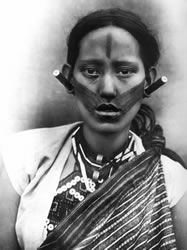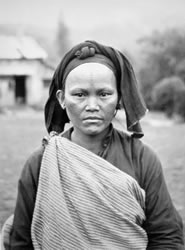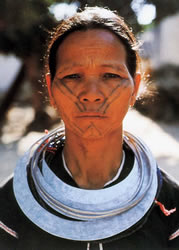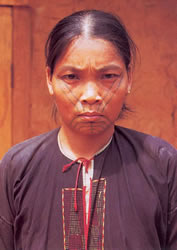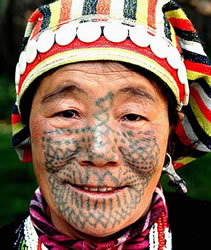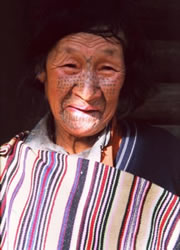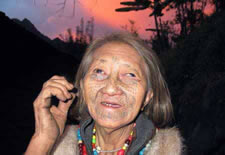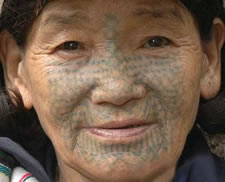Wen Shen: The Vanishing Art of Chinese Tribal Culture
Article © 2009 Lars Krutak
Tattooed Headhunters of Taiwan
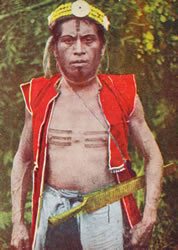 |
|
Saiset
warrior with tattooed forehead
and
chest, ca. 1930. |
The Atayal, like the Paiwan, Rukai and Saiset, also marked success on
the headhunt with tattoos. However, these markings were placed on the
foreheads and torsos of valiant warriors in different set patterns. Those headhunters who acquired more than five heads with their
machete-like beheading sword might also have tattooed their chests or
the backs of their hands. One Atayal elder recounted in the 1940s that
headhunting was believed to induce rapid growth in village children
which was a desirable outcome:
"After our young men return from killing, they tattoo their
foreheads and chins. Even when they went to kill someone our
ancestors took many people, even their children, with them. Then,
from the head taken, they distributed one hair to each of the
children. After they returned, these people who went out to kill
were all tattooed. As a result of this, the children grew with the
speed of the wind! According to the Atayal custom, a man who has
killed many men tattoos his chest. A man who has killed only a few
does not tattoo his chest.
When we return from killing, we return with our voices raised in
the war cry along the road. When we get home we all go to the place
for the heads and sing. On the following day we assemble and dance,
and put the heads in the head stockade. We always place rice flour
cakes, which our wives have pounded, into the mouths of the heads.
Taking them out again, we let the children of those of us who have
returned from head-hunting eat them. We make owao [millet wine] in
celebration, and also go hunting. When our owao is mature, we always
invite everyone in the whole village. Then everyone comes and drinks
our owao."
The Atayal also administered tattoos to the foreheads of unmarried
boys and girls. Apart from these tattoos, only those girls who were
skillful in weaving could tattoo their cheeks and other parts of the
body. Interestingly, it should be noted here that the base structure of
these intricate cheek tattoos resemble the diagonal facial tattoo bands
worn by Li women of the Qi and Ha tribes. Of course, these
Li tattoos are much simpler in form but it is possible that both forms
of facial tattooing are ultimately derived from the same original source
posing profound questions that are difficult to answer today.
The Dulong Women of Yunnan
In a remote corner of northwestern China, facial tattooing (baktuq-ru)
among women of the animistic Dulong (or Drung) people was common until
the founding of the People's Republic of China. Young women were
tattooed in their early teens with a distinctive design that was unique
to their home region.
The purpose of these tattoos is the stuff of legends. First, they are
said by some to have deterred Tibetan slave traders and other enemies
from kidnapping the fair "maidens" of the mountains. Others speculate
that these dark-blue markings prevented Dulong women from being lured
away by the impulses of modern living in the cities because of their
permanent disfigurations. One local Chinese researcher has reported that
the marks signaled the attainment of puberty and that each clan owned a
specific pattern and worked as a kind of identification mark.
Whatever the reason, the Chinese census of 2003 noted that sixty-five
tattooed Dulong women continued to live in the mountains above the steep
banks of the isolated Dulongjiang River near Tibet. Much of the region
lies 4,000 meters above sea-level and is usually cut-off from the rest
of the world for at least six months a year by heavy snowfall. Today,
there are less than forty tattooed Dulong women and perhaps the youngest
was tattooed in the early 1960s: the rest are between seventy and one
hundred years of age. The Chinese government abolished Dulong tattooing
for good in 1967.
Recently, one of the oldest women (98 years-old) to wear her
hard-earned markings said she could not remember when, or why, her face
was tattooed. All she could report was that she was there with two other
girls from her village and, "We all cried in agony."
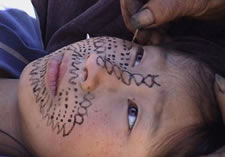 |
|
A simulation
of Dulong tattoo stenciling, 2004.
Photograph © Stephanie Gros. |
The pointillinear tattoos resemble a butterfly with its body and
antennae moving up along the bridge of the nose to the forehead, and its
wings spread across the cheeks and face. After a stencil was made, the
design was created with bamboo needles dipped in a sooty ink made of
charcoal mixed with saliva and water. The tattoo operation
lasted up to seven or eight hours, and the women were told not to wash
their wounds for several days in the fear that the pattern would not
remain intact. Payments ranged from a basket of taro or bread, to a
portion of alcohol or even a knife.
Some Dulong women have said that they were tattooed with the
butterfly pattern because it is beautiful. Upon being interviewed,
another elder declared: "The image of the butterfly is associated with
passage in Dulong culture. The souls of the dead are thought to change
into butterflies."
Next Page
|
1
|
2
|
3
|
4
|
5
|


